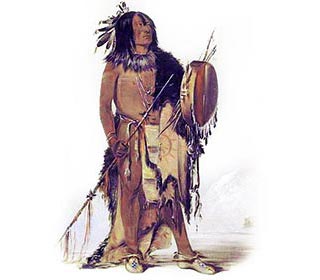- Geography of the State of Arctic Indians: There was enough rain for a thick layer of grass, which attracted large herds of grazing animals like the bison (buffalo). There was not enough rain to grow many trees which were only found by rivers
- Animals: Bison (Buffalo), deer, elk, bear, beaver, porcupine, antelope and wolves
- Culture and Lifestyle adopted: Nomadic Hunters and farmers
- Transport: Horse, travois, parfleche
- Types of housing, homes or shelters: Tepees were used by the nomadic hunters. The semi-nomadic Mandan used tepees but also maintained permanent earth lodge villages situated along rivers. The Wichita and Caddo continued to build houses of grass. The farmers used Earth lodges
- Famous Tribes of Great Plains Indians: Blackfoot, Cheyenne, Pawnee, Crow, Comanche and Arapaho
- The Native Indians who lived on the borders of lands often reflected two different types of lifestyles.
Great Plains Indians - Languages and Way of Life
The languages of the Great Plains Indians included Siouan, Algonquian, Uto-Aztecan, Caddoan and Athabaskan. The introduction of the horse in the 1750's enabled many Indian tribes from other regions to travel to the Great Plains to hunt buffalo. The Great Plains hunting culture was relatively short lived as it was replaced in the 1880's by the European settlers who became the farmers, cowboys and cattlemen. In the 1870's the deliberate great slaughter of the northern bison herds began designed to prevent the Native Indians continuing the Great Plains lifestyle. Great Plains Indians - Indian Territory
Indian Territory was a vast area of U.S. federal territory on the Great Plains reserved for Indians from the 1830s to the 1880s. Indian Territory eventually became the states of Kansas, Nebraska, and Oklahoma. By 1907, when Oklahoma was admitted as a state, Indian Territory ceased to exist. Great Plains Indians - Physical Characteristics
The physical characteristics of Great Plains Indians are dark brown eyes, prominent cheek bones, straight black hair, and scantiness of beard. The skin color of Native Indians varies from very light in some tribes such as the Cheyenne, to almost black in others, such as the Caddo and a yellowish color in such as the Flatheads.
Great Plains Indians - Geography and Environment
The Great Plains area includes the States of Iowa, Kansas, Minnesota, Missouri, Nebraska, North Dakota and South Dakota. The Geography and Environment can be generally described as hot summers and cold winters. Grass covered prairies. Some streams and rivers.
Great Plains Indians - Animals
The animals were very important to the Great Plains Indians. Animals included Bison (Buffalo), deer, cougars, elk, bear, beaver, porcupine, antelope, prairie dogs, eagles and wolves. The uses of the animals were varied and included food, clothing, shelter and decorations.
Great Plains Indians - Houses, Shelters and Homes
The different types of Houses, Shelters and Homes depended on the materials available and whether the home was permanent or temporary. The homes of the Great Plains Indians included tepees which were suitable for their nomadic lifestyles.
Great Plains Indians - Religion, Ceremonies and Beliefs
The Religion, Ceremonies and Beliefs were based on Animism. Animism was a commonly shared doctrine, or belief, of the indigenous people of North America and Canada including the Great Plains Indian tribes. Animism is based on the spiritual or religious idea that the universe and all natural objects have souls or spirits. In this religion it is believed that souls or spirits exist not only in humans but also in animals, plants, trees, rocks etc. This belief is also extended to natural phenomena such as thunder storms and rain and geographic features such as mountains, caves or rivers also possess souls or spirits. The Plains people believed in Manitou, the Great Spirit. The men also carried a pouch called the 'Medicine Bag or Bundle' which included herbs used in Smudging Rituals. The Great Spirit, the Sun Dance and Vision Quest. Tricksters feature in the legends and mythology of the Plains peoples as do heroic figures or "transformers" who transform, or change, the world into its present state. Great Plains Indians - The Great Spirit
Plains Indians believed in a great god, the Sioux called that god the ‘Wakan Tanka,’ which means the Great Spirit. Great Plains Indians - Vision Quest
A vision quest was an attempt to achieve a vision of a future guardian spirit often through the process of fasting or self-torture Great Plains Indians - The Sun Dance
The Sun Dance was a ceremonial dance performed by North American Plains Indians in honor of the sun at the summer solstice. This mystic ceremony was to prove bravery by overcoming pain. It was typically marked by several days of sleepless fasting and group dancing. Ritualized self-torture was undertaken as a penance or to induce a Trance State or vision. Great Plains Indians - The Blackfoot Confederacy
The Blackfoot Confederacy consisted of the Piegan people, the Blood people called the Kainai, the Blackfoot People also called the Siksika which means 'Blackfoot' and the Sarcee tribe. Great Plains Indians - Other Tribes of the Great Plains
The other tribes of the Great Plains Indians known to inhabit the area were the Arikara, Assiniboin, Caddo, Cherokee, Chippewa, Dakota (Sioux), Delaware, Fox, Gros Ventre Hidatsa, Illinois, Iowa, Iroquois, Kansa, Kickapoo, Kiowa, Kiowa Apache, Miami, Mandan, Missouri, Munsee, Ojibwa, Omaha, Osage, Otoe, Ottawa, Peoria, Ponca, Potawatomi, Quapaw, Sauk, Seneca, Shawnee and Wyandot (Huron) tribes |
